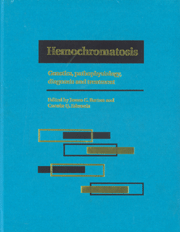Book contents
- Frontmatter
- Contents
- List of contributors
- Foreword
- Part I Introduction to hemochromatosis
- Part II Genetics of hemochromatosis
- Part III Metal absorption and metabolism in hemochromatosis
- Part IV Diagnostic techniques for iron overload
- Part V Complications of iron overload
- Part VI Therapy of hemochromatosis and iron overload
- Part VII Infections and immunity in hemochromatosis
- Part VIII Hemochromatosis heterozygotes
- Part IX Relationship of hemochromatosis to other disorders
- Part X Animal models of hemochromatosis and iron overload
- 47 β2-microglobulin-deficient mice as a model for hemochromatosis
- 48 Animal models of iron overload based on excess exogenous iron
- 49 Naturally occurring iron overload in animals
- Part XI Screening for hemochromatosis
- Part XII Hemochromatosis: societal and ethical issues
- Part XIII Final issues
- Index
49 - Naturally occurring iron overload in animals
from Part X - Animal models of hemochromatosis and iron overload
Published online by Cambridge University Press: 05 August 2011
- Frontmatter
- Contents
- List of contributors
- Foreword
- Part I Introduction to hemochromatosis
- Part II Genetics of hemochromatosis
- Part III Metal absorption and metabolism in hemochromatosis
- Part IV Diagnostic techniques for iron overload
- Part V Complications of iron overload
- Part VI Therapy of hemochromatosis and iron overload
- Part VII Infections and immunity in hemochromatosis
- Part VIII Hemochromatosis heterozygotes
- Part IX Relationship of hemochromatosis to other disorders
- Part X Animal models of hemochromatosis and iron overload
- 47 β2-microglobulin-deficient mice as a model for hemochromatosis
- 48 Animal models of iron overload based on excess exogenous iron
- 49 Naturally occurring iron overload in animals
- Part XI Screening for hemochromatosis
- Part XII Hemochromatosis: societal and ethical issues
- Part XIII Final issues
- Index
Summary
Introduction
Iron metabolism has been studied extensively in humans due to two widespread diseases – iron deficiency and hemochromatosis. Because most living organisms require iron to survive, iron is also important in non-human animals. Each year, thousands of pounds of inorganic iron compounds are injected in, or fed to animals. For example, most pigs in the United States receive 200 mg of iron in the first few days of life. Iron overload might be expected to occur under non-experimental conditions. It also develops naturally from chronic hemolytic anemia and genetic, iatrogenic, dietary and unknown causes. This review discusses specific examples of these disorders.
Genetic causes of iron overload
Saler cattle
A condition occurs in the Saler breed of cattle that appears to be analogous to human hemochromatosis. Originally, three animals had a history of poor growth, weight loss, and rough hair coat of several months’ duration. Their condition did not improve after anthelmintic or antibiotic therapy by the owners. When they were first evaluated by veterinarians, they were small for their age and had poor body condition, poor hair coat, and diarrhea. No hematologic or abnormalities were found, but hepatic function was impaired (Table 49.1). Serum γ-glutamyl transferase was increased, sulfobromophthalein (BSP) half-time was prolonged, and hepatic iron concentration was increased.
Two animals deteriorated despite therapeutic phlebotomies and were euthanized. One heifer responded favorably to phlebotomy and gained weight. Animals that were necropsied had enlarged nodular livers.
- Type
- Chapter
- Information
- HemochromatosisGenetics, Pathophysiology, Diagnosis and Treatment, pp. 508 - 516Publisher: Cambridge University PressPrint publication year: 2000
- 2
- Cited by



